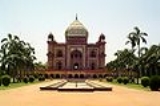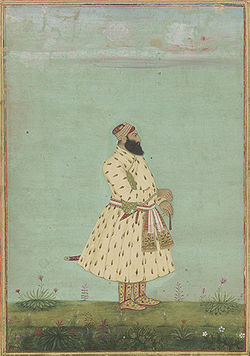
Safdarjung's Tomb
Encyclopedia
Safdarjung's Tomb is a garden tomb with a marble mausoleum in New Delhi
, India
. It was built in 1754 in the late Mughal Empire style
, and was described as "the last flicker in the lamp of Mughal architecture". The top storey of the edifice houses the Archaeological Survey of India
. The garden, in the style evolved by the Mughal Empire
that is now known as the Mughal gardens
style influenced by Persian gardens
style, is entered through an ornate gate. Its facade is decorated with elaborate plaster carvings.
 The mausoleum has lent its name to Safdarjung Airport
The mausoleum has lent its name to Safdarjung Airport
, Safdarjung Road
, Safdarjung Terminal, Safdarjung Hospital, and localities like Safdarjung Enclave
and Safdarjung Development Area (SDA), all nearby in New Delhi
.
, the powerful prime minister of Muhammad Shah
who was the weak Mughal emperor from 1719 to 1748.
The central tomb has a huge dome. There are four water canals leading to four buildings. One has an ornately decorated gateway while the other three are pavilion
s, with living quarters built into the walls. Octagonal towers are in the corners. The canals are four oblong tanks, one on each side of the tomb.
Delhi
Delhi , officially National Capital Territory of Delhi , is the largest metropolis by area and the second-largest by population in India, next to Mumbai. It is the eighth largest metropolis in the world by population with 16,753,265 inhabitants in the Territory at the 2011 Census...
, India
India
India , officially the Republic of India , is a country in South Asia. It is the seventh-largest country by geographical area, the second-most populous country with over 1.2 billion people, and the most populous democracy in the world...
. It was built in 1754 in the late Mughal Empire style
Mughal architecture
Mughal architecture, an amalgam of Islamic, Persian, Turkish and Indian architecture, is the distinctive style developed by the Mughals in the 16th, 17th and 18th centuries in what is now India, Pakistan, Bangladesh and Afghanistan. It is symmetrical and decorative in style.The Mughal dynasty was...
, and was described as "the last flicker in the lamp of Mughal architecture". The top storey of the edifice houses the Archaeological Survey of India
Archaeological Survey of India
The Archaeological Survey of India is a department of the Government of India, attached to the Ministry of Culture . The ASI is responsible for archaeological studies and the preservation of archaeological heritage of the country in accordance with the various acts of the Indian Parliament...
. The garden, in the style evolved by the Mughal Empire
Mughal Empire
The Mughal Empire , or Mogul Empire in traditional English usage, was an imperial power from the Indian Subcontinent. The Mughal emperors were descendants of the Timurids...
that is now known as the Mughal gardens
Mughal Gardens
Mughal gardens are a group of gardens built by the Mughals in the Islamic style of architecture. This style was heavily influenced by the Persian gardens particularly the Charbagh structure. Significant use of rectilinear layouts are made within the walled enclosures...
style influenced by Persian gardens
Persian Gardens
The tradition and style in the garden design of Persian gardens has influenced the design of gardens from Andalusia to India and beyond. The gardens of the Alhambra show the influence of Persian Garden philosophy and style in a Moorish Palace scale from the era of Al-Andalus in Spain...
style, is entered through an ornate gate. Its facade is decorated with elaborate plaster carvings.

Safdarjung Airport
Safdarjung Airport also is an airport in New Delhi, India, in the neighbourhood of the same name. Established during the British Raj, as Willingdon Airfield, it started operations as an airport in 1929, when was the India's second airport and Delhi’s only airport...
, Safdarjung Road
Safdarjung Road
Safdarjung Road is a main road, in New Delhi, India, named after 18th century Safdarjung's Tomb near it. At the north end, the road stretches from the junction of Teen Murti Marg, Akbar Road, Rajaji Marg and Racecourse Road, which is a roundabout...
, Safdarjung Terminal, Safdarjung Hospital, and localities like Safdarjung Enclave
Safdarjung (Delhi)
Safdarjung area consists of mainly two localities in South Delhi, namely Safdarjung Enclave and Safdarjung Development Area...
and Safdarjung Development Area (SDA), all nearby in New Delhi
New Delhi
New Delhi is the capital city of India. It serves as the centre of the Government of India and the Government of the National Capital Territory of Delhi. New Delhi is situated within the metropolis of Delhi. It is one of the nine districts of Delhi Union Territory. The total area of the city is...
.
Description
The tomb was built for SafdarjungSafdarjung
Safdarjung was the Subadar Nawab of Oudh from 19 March 1739 to 5 October 1754.-Life:Safdarjung was born as Muhammad Muqim in Khurasan, Persia and migrated to India in 1722.-Career:...
, the powerful prime minister of Muhammad Shah
Muhammad Shah
Muhammad Shah also known as Roshan Akhtar, was a Mughal emperor of India between 1719 and 1748. He was son of Khujista Akhtar Jahan Shah, the fourth son of Bahadur Shah I. Ascending the throne at 17 with the help of the Sayyid Brothers, he later got rid of them with the help of Nizam-ul-Mulk Chin...
who was the weak Mughal emperor from 1719 to 1748.
The central tomb has a huge dome. There are four water canals leading to four buildings. One has an ornately decorated gateway while the other three are pavilion
Pavilion (structure)
In architecture a pavilion has two main meanings.-Free-standing structure:Pavilion may refer to a free-standing structure sited a short distance from a main residence, whose architecture makes it an object of pleasure. Large or small, there is usually a connection with relaxation and pleasure in...
s, with living quarters built into the walls. Octagonal towers are in the corners. The canals are four oblong tanks, one on each side of the tomb.
See also
- SafdarjungSafdarjungSafdarjung was the Subadar Nawab of Oudh from 19 March 1739 to 5 October 1754.-Life:Safdarjung was born as Muhammad Muqim in Khurasan, Persia and migrated to India in 1722.-Career:...
- Shalimar Gardens (Lahore)Shalimar Gardens (Lahore)The Shalimar Gardens , sometimes written Shalamar Gardens, is a Persian garden and it was built by the Mughal emperor Shah Jahan in Lahore, modern day Pakistan. Construction began in 1641 CE and was completed the following year...
- Shalimar Gardens (Kashmir)Shalimar Gardens (Kashmir)Shalimar Bagh, , is a Mughal garden linked through a channel to the northeast of Dal Lake, on its right bank located at near Srinagar city in the Jammu and Kashmir. Its other names are Shalamar Garden, Shalamar Bagh, Farah Baksh and Faiz Baksh, and the other famous shore line garden in the...
- LucknowLucknowLucknow is the capital city of Uttar Pradesh in India. Lucknow is the administrative headquarters of Lucknow District and Lucknow Division....
- AwadhAwadhAwadh , also known in various British historical texts as Oudh or Oude derived from Ayodhya, is a region in the centre of the modern Indian state of Uttar Pradesh, which was before independence known as the United Provinces of Agra and Oudh...

